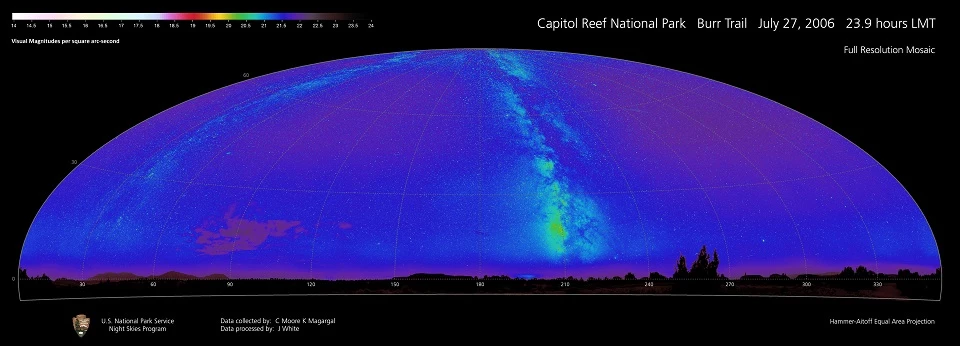
NPS Artist-in-Residence Phil Sisto Discover Capitol Reef National Park's dark night skies. Designated an International Dark Sky Park in 2015, Capitol Reef offers many opportunities to experience near-pristine night skies.The night sky is everyone's heritage; however, natural darkness is becoming rare. Capitol Reef National Park has some of the best night sky viewing opportunities of the western national parks. For more information, visit the Natural Sounds and Night Skies Division of the National Park Service. 
NPS Natural Night Skies and AnimalsFor billions of years, life has relied upon the predictable rhythm of day and night (circadian rhythm). It is in the DNA of all living things. It guides behaviors such as sleep, protection from predators, finding food, and reproduction. The cover of darkness allows animals to hide or aids in stealth. Imagine animals working in shifts: day shift, evening, night. This shift work allows noctural animals to share resources such as food, water, and space with daytime animals; it lessens competition. Even animals typically thought of as daytime creatures, like birds, make use of the dark. Approximately half of all birds in the U.S. are migratory and they rely upon the darkness of night during the often long and arduous process of moving from breeding grounds to wintering grounds. The darkness allows them to hide from predators. Cooler temperatures and less air turbulence help them to use less energy, and they find their way using the stars as a guide. Capitol Reef National Park is home to many nocturnal desert animals: ringtails, raccoons, kangaroo rats, night snakes, and owls; as well as 16 species of bats (which are 20% of all mammal species). Bats feed on insects, which in turn pollinate plants; in fact, both bats and insects pollinate plants that provide food we eat. Bats pollinate over 300 species of fruit, including mangos and bananas. Wildlife and plants benefit us, and need darkness to thrive, as do humans. Night Skies and PeopleUntil recently, humans saw pristine night skies filled with innumberable stars and the Milky Way. The night sky has inspired science, religion, philosophy, art, and more. It has kept us entertained and given rise to poetry, myths, and legends. The North Star guided the way to freedom for enslaved people in the United States. There are physical and biological needs and benefits, too. Healthy skies help humans to have healthy lives. Darkness allows humans to produce melatonin, an hormone which helps us sleep, among other things. When people are exposed to artifical light, there can be consequences for our health.
NPS/Nathan Gross Impacts of Light PollutionLight pollution not only threatens the ability to enjoy the stars, it threatens human health and the health of all living things. The birds that use the stars to migrate are impacted. Artificial light can cause them to lose their course, run into lit buildings, or migrate at the wrong time. Insects that pollinate food plants are drawn to artificial light. This exposes insects to increased predation and can affect the food web. Insect populations around the world are declining, which negatively impacts all species that rely on insects for food or pollination. 

Left image
Right image
Protect Night SkiesLight pollution is the probably easiest form of pollution to fix. It is as easy as flipping a switch, closing a shade, and changing light bulbs at home. Simply turn off outside lights, and make sure the blinds and curtains are closed. Choose the right kind of light and shield it. On a larger scale, many communities are receiving dark sky designations, such as Torrey, Utah’s first dark sky community, and Flagstaff, Arizona, the first ever dark sky community and home to the Lowell Observatory. Help uncover the darkness of night again! Night Sky Ranger Videos
Visit our keyboard shortcuts docs for details
Ranger Jeff discusses night sky photography The requested video is no longer available.
The requested video is no longer available.
The requested video is no longer available.
|
Last updated: May 29, 2025
